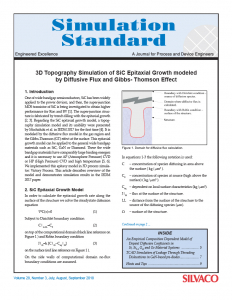3D Topography Simulation of SiC Epitaxial Growth Modeled by Diffusive Flux and Gibbs-Thomson Effect
1. Introduction
One of wide bandgap semiconductors, SiC has been widely applied to the power devices, and then, the super-junction MOS transistor of SiC is being investigated to obtain higher performance for Ron and BV [1]. The super-junction structure is fabricated by trench filling with the epitaxial growth [2, 3]. Regarding the SiC epitaxial growth model, a topography simulation model and its usability were presented by Mochizuki et al. in IEDM 2017 for the first time [4]. It is modeled by the diffusive flux model in the gas region and the Gibbs-Thomson (GT) effect at the surface. This epitaxial growth model can be applied to the general wide bandgap materials such as SiC, GaN or Diamond. These the wide bandgap materials have comparably large binding energies and it is necessary to use AP (Atmosphere Pressure) CVD or HP (High Pressure) CVD and high temperature [5, 6]. We implemented this epitaxy model in 3D process simulator: Victory Process. This article describes overview of the model and demonstrates simulation results in the IEDM 2017 paper.



